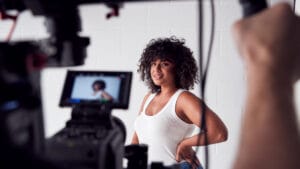Your Theatre Training Won’t Necessarily Get You On Set
Understanding the story, playing what's on the page, and mastering your relationship with the camera are critical components. Embrace the technical aspects, seek continuous improvement, and engage with a supportive community.

Does this sound familiar? You go to conservatory, get your BFA or MFA in Dramatic Arts—you graduate, ready to become a working actor, only to find out that you can’t book a two-line co-star role on a TV show?
It’s incredibly frustrating. And that’s exactly what happened to me.
In my first year in LA, fresh out of grad school, I won a theatre award for “Best Comedic Performance” but couldn’t land a role on TV where all I had to say was: “Here’s your coffee, ma’am.”
Where was all this talent that showed up on stage? Why couldn’t I capture it in my TV auditions?
The harsh truth is, you can be incredibly talented, but if you don’t know how to capture that talent on your self-tape—you won’t be competitive in this new landscape.
The industry has changed dramatically in the last six years. The pandemic has made self-tapes an industry standard, but traditional actor training has not caught up to the new skills that are required to be a working actor today.
Why Self-Tape Skills Are Essential
Self-taping is more than just pressing record on your camera or phone. It’s about creating a mini-performance that encapsulates your character, the story, and your unique take on the material.
Plus they are a GREAT training ground for what your experience on set will actually be like. Unlike in-person auditions, where you might get immediate feedback from a casting director, a TV set moves fast.
More often than not, you will only get feedback when you are missing your mark. Getting comfortable with self-taping will make you a better collaborator on set. The process of mastering self-tapes can be daunting but also incredibly empowering once you master them.
Practice Makes Perfect
Like any other skill, becoming proficient at self-taping requires practice.
Create a regular practice routine where you can work on different types of scenes. Watch your recordings critically and make notes on what works and what doesn’t. Seek feedback from trusted mentors who understand the nuances of self-taping.
Be Patient and Persistent
Transitioning from stage to screen is a journey that takes time. Be patient with yourself and recognize that every audition is a learning opportunity. Persistence is key. The more you work on honing your self-tape skills, the more natural and effective you will become in front of the camera.
So here are three tips you need to know about how to approach your self-tape auditions for TV vs Theatre:
1. Understand Story Before You Think About Your Character Choices
Theatre trains you to enter the story through a character lens because the director is there to shape the story for you. Plays tend to be more malleable and can be interpreted differently based on what the director wants to say with the piece.
For TV, the writers have spent months shaping the story, and there are not many story choices for the director to make because TV is plot-driven.
So a TV actor needs to understand why and how their character moves the plot forward and then make choices that best support that path.
This means analyzing the script not just for your character’s development but for the overall arc of the episode or series. It’s about seeing the bigger picture and understanding your place within it.
2. Everything You Need Is On the Page for TV Auditions
In theatre, we are taught to spend time creating a character’s backstory. That is much easier to do when you are dealing with a contained story like a play.
Not so much when you are working on TV sides. The story can change episode to episode. If you spend time creating a backstory, it might conflict with a future episode that you, as an actor, aren’t privy to.
Play what’s on the page. There is plenty of information there to activate the scene if you know what you are looking for. It will make your prep time much faster when you work this way.
Focus on the script’s given circumstances, the relationships, and the point of view of your character. These are the keys to delivering a grounded and compelling performance.
3. It’s Not the Size of Your Performance, It’s Your Relationship to the Camera
Many theatre actors always hear that they are “too big” in front of the camera. So they are directed to play it small, stay still, and have it all happen in your eyes.
This stifles so many actors and makes them scared to express themselves. Instead, think about your relationship to the camera and how that affects movement.
If you are in a close-up, then yes, stillness is required. But if you have more room in the frame, we need to see you move.
This is a visual medium. Gestures are a part of that visual language—so don’t be afraid of movement.
Understanding the framing of your shot—whether it’s a close-up, medium shot, or wide shot—can help you adjust your performance accordingly.
Your theatre training provides a strong foundation, but adapting those skills for the screen, especially through self-tapes, requires additional focus and consistent practice.
That’s why Alyshia (host of That One Audition podcast) and I came together to create The Bridge for Actors.
As working actors ourselves, we are passionate about bridging the gap of traditional actor training so that you can have a career BOTH on stage and onscreen.
Understanding the story, playing what’s on the page, and mastering your relationship with the camera are critical components. Embrace the technical aspects, seek continuous improvement, and engage with a supportive community.


